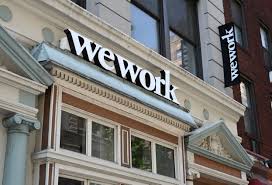Would You Invest In WeWork? Here’s the Bull and Bear Case Before Its IPO

The We Company, the holding company behind office-sharing giant WeWork, is set to be an enormously divisive stock once it debuts as public company later this year.
Investors predict it will change the world as we know it—or be a money-losing disaster—seemingly with little middle ground. And it indeed has the perfect ingredients for debate: A sky-high valuation, a lack of profits, impressive growth, and an unconventional, effusive founder.
The company is liability-heavy, overvalued in a space that is ostensibly easily copied, and is going public at a time when global markets are slowing, fanning recession fears. At the same time, investors have plowed billions into the company (which plans to list under the stock symbol “WE”) for a reason. Put on the rose-tinted glasses, the growth story WeWork tells is compelling. Riding on the rising mobile office trend, WeWork is disrupting a potentially massive market.
Here’s the most bullish (and bearish) case.
Bullish
Growth has been huge
WeWork’s revenue doubled to $ 1.8 billion in 2018. For companies, washing the dishes, fixing the WiFi, replacing the lightbulbs, or other so-called back office operations, are generally not things they excel at. That’s especially the case for startups and gig economy workers.
“We love WeWork,” said Coterie co-founder Sarah Raffa. “It’s convenient, and it’s nice to have access to a larger group of people.”
The party supply startup with six employees initially opted to build out its own offices, but struggled with a frustrating string of logistical complications—getting hot water being among the to-dos. The team eventually decided to rent a WeWork space, and have been happy customers since.
Not too long ago, co-working spaces were considered a fad that would come and go with the gig economy. But companies including WeWork have sought not only to maintain their existing small company clientele, but also reach out to corporations such as IBM, which is now a customer of the co-working firm. And there is a believable argument for why larger corporations should outsource their offices.
“For companies, [building an office] is not a core competency of theirs,” said Industrious CEO Jamie Hodari. (Industrious is the third largest office sharing company stateside.) Companies like Industrious say this ability to focus on improving office design by gathering data on worker satisfaction and correlating that with features of the building—how close do they need to be to a window, for example, or does a certain amenity lower the chances of the worker leaving the company—can be valuable for larger firms who want to focus on getting a product out the door rather than the auxiliary work that gets it there.
WeWork’s prospectus emphasizes that 80% of members reported increased productivity after joining, and 78% of enterprise members say WeWork helped attract and retain talent.
Losses may be less egregious than they look
WeWork’s losses in 2018 were jaw-dropping. At $ 1.9 billion, the company was massively outspending its $ 1.8 billion revenue.
But that could be oversimplifying the picture. The company has stepped hard on the accelerator when it comes to new locations, adding over 300 between 2016 to 2018, which could put those losses in context, per Ben Thompson’s Stratechery. Indeed new locations will be in the red for months before they can onboard customers and generate revenue. Bulls argue that if WeWork stopped expanding now and allowed its locations to mature, dots of green could appear across the map.
Should WeWork achieve scale, bulls say, the company also then has more power to exert pricing pressure on its suppliers, giving the firm more negotiating power on rent prices and other office products, says Sandy Kory, managing director at Horizon Partners.
The problem? It’s mostly guesswork—conjecture rather than fact. The filing fails to disclose whether WeWork locations for instance are profitable after a certain number of months, as WeWork’s filing is light on location-specific detail. But more on that below.
It’s a large potential market
WeWork is effectively targeting all office spaces, per its S-1. The company is already in 111 cities, and plans to boost that figure to 280. From there, it is targeting a population of 255 million potential customers.
“We expect to expand aggressively in our existing cities as well as launch in up to 169 additional cities,” the filing reads.
Commercial real estate, says Kory at Horizon, is also incredibly ripe for disruption. “WeWork is not a Facebook or Google, but the commercial real estate is a neanderthal industry. It’s based on nepotism,” said Kory, who says he is not necessarily the most bullish person on WeWork, but thinks parts of the business are underrated. “The question is, can WeWork improve their unit economics every year?”
The first mover advantage
WeWork is the largest co-working network in the U.S., with 528 locations around the world and 527,000 memberships.
Not only is it likely the first name that comes to mind when consumers think about “co-working”—but WeWork’s growing global network is attractive at a time when workforces are becoming more dispersed and companies will have to consider whether they want to deal with the hassle of opening up a fresh office abroad.
Granted, WeWork has competitors. Other co-working companies including Knotel and Industrious have recently raised more funding. But WeWork hasn’t sat on its laurels,and has been active in the M&A space, recently acquiring an adjacent business, Spacious.
BEAR
WeWork is overvalued
WeWork skeptics often point to a competitor that is profitable yet valued at significantly less, IWG, as an argument that investors have poured too much capital into the company. That Luxembourg-based business for instance posted revenue of $ 3.4 billion and income of $ 149.7 million in 2018; WeWork posted revenue roughly half of that at $ 1.8 billion in 2018 and a loss of $ 1.9 billion. Yet WeWork was last valued at $ 47 billion, while IWG commands less than a tenth of that at $ 4.5 billion in market capitalization.
Notably, WeWork dismisses comparisons to IWG, instead calling itself a tech company at heart.
But even when compared to tech company with similar top and bottom-line metrics that recently went public, its valuation remains a head scratcher, says the founder of Equity Zen, a market for private company shares, Phil Haslett.
Ride-hailing firm Lyft posted revenue that doubled to $ 2.2 billion in 2018 and a losses grew 32% to $ 911 million year-over-year. Yet that company is valued at about $ 15 billion. To be fair, Lyft operates in a completely different business. However, “In regards to WeWork, we have seen lackluster interest, particularly compared to other IPOs like Spotify, Slack, Docusign,” he said.
It has a lot of debt
WeWork takes on long-term leases on buildings, and in turn rents out the space to consumers and businesses on a short-term period.
That mismatch puts WeWork at significant risk if there is a downturn. WeWork members typically pay on a monthly basis, with cancellations expected to tick upward in in global recession. But the company is on the hook to pay at minimum $ 47.2 billion in the future, with leases lasting an average 15 years as a result of the office spaces it has rented.
“While our business has withstood localized recessions in various geographies, we have yet to experience a global economic downturn since founding our business,” the filing reads.
Too much depends on Adam Neumann
There’s not a whole lot of “we” in WeWork’s corporate structure. While the company invokes its “community” 150 times in its prospectus and is slated to list under the symbol “WE,” investors will have little say in how the company is run by CEO and founder Adam Neumann, who will continue controlling the firm following the IPO via a dual class share structure.
Based on the filing alone, such structure would be a positive as: “We believe [Neumanns’] strategic insight, leadership and commitment to the growth of our global team and community will provide us the leadership we need to execute our vision,” the filing reads.
But Neumann’s control comes with real cost. As payment for a dual-class share structure, shares of the We Company will be excluded from major indices including the S&P 500—meaning popular index fund won’t buy “WE” shares. Moreover, the traditional checks-and-balances traditionally imposed on companies between the CEO and his or her board dissolves with the dual-class share structure, with the CEO holding the ability to appoint directors.
Much of the recent negative sentiment surrounding WeWork has also centered on Neumann and his dealings with the company. Ahead of the IPO, Neumann was reported to have cashed out than $ 700 million through a mix of stock sales and debt. In the filing, WeWork also revealed that it paid Neumann’s company $ 5.9 million for rights to use “We,” a fact that raised more than a few eyebrows.
“Founders deserve a lot of credit,” said Kory. But he notes, Neumann “appears to be a little capricious.”
And unlike a growing number of companies that have begun imposing clauses limiting the length of time a founder controls a company even in a dual-class setting, WeWork has made an unusual move to ensure control remains in the family: In the event that Neumann can no longer serve as CEO before 2029, his wife, Rebekah Neumann, will work with two board members to pick a successor, the S-1 filing specifies.
“They took something intrinsically simple, and made it complicated.”
That’s according to Rett Wallace, CEO and founder of Triton, a firm that focuses on evaluating new listings.
WeWork’s first IPO filing leaves investors with a basin of questions. While the firm does provide a macro level picture of the company, it fails to discuss operations on a per location level that is important in deciding whether a company should in fact be expanding to new locations. Wallace, like Kory, says he would like to see the unit economics of individual locations and understand how long it takes for each one to become profitable in different geographies, a factor that could help investors understand if WeWork at large can scale and become more profitable with each subsequent location.
Moreover, WeWork has also been criticized unconventional ways of measuring itself as a tech company. The company evaluates its profitability with the so-called “contribution margin including non-cash GAAP straight-line lease cost.” The measure though leaves out several expenses, including depreciation and amortization—a move that may make sense for a software company with very little in the ways of physical assets, but doesn’t seem to line up when it comes to WeWork. Its offices are stocked with chairs, tables, kitchens and other physical items that are certain to devalue with time.
“The growth is incredible. Their size is incredible. What makes it remarkable in every single way is that they are asking for all this money without a cogent explanation for why investors should hand it over,” Wallace said. “You think I need something custom and extra brain damage and complexity? Just serve up the math.”
So even while the business model does have a place and has a chance at growing, the company’s pretzel-like accounting structure alongside its convoluted corporate pecking order, sky-high valuation, and somewhat incestuous financial dealings with Neumann have certainly left some investors dubious.
More must-read stories from Fortune:
—For tech companies going public, IPO-related lawsuits are an unwanted side effect
—GE’s basic businesses are badly underperforming, by this accounting metric
—Ex-Fannie Mae CEO: Housing will be fine in the next recession
—100-year bonds? Why “ultra-long” bonds have caught on in 14 countries and counting
—What a disappointing car auction tells us about the 1%—and the economy










